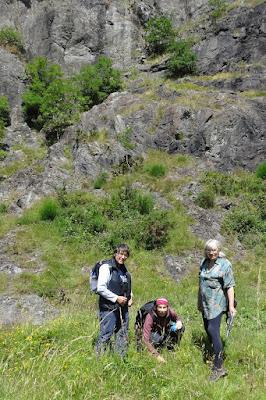A few more pictures have come in from the Field excursions in the mid-July BSBI get together in Brecon.
First Stanner Rocks
Where the Spiked Speedwell was magnificent.
Spiked Speedwell,
Rhwyddlwyn pigfain
or
Veronica spicata
And a real rarity - only found at Stanner in the UK
Perennial Knawel,
Dinodd parhaol Maesyfed
or
Scleranthus perennis subsp. perennis
Cwm Cadlan - updated (thanks Stephen)
Andy Jones addressing the key features of Juncus x kernreichgeltii
Lunch
Broad-leaved Cottongrass,
Plu’r gweunydd llydanddail
or
Eriophorum latifolium (the less common one - habitat)
Where Marsh Helleborines were abundant
Marsh Helleborine,
Caldrist y gors
or
Epipactis palustris
Next, the intrepid exploration of the cliffs below Cribyn and Pen y Fan
The way up
On the cliffs
Some of the special plants found up on the north slopes of the Fans
Spring Sandwort
or
Minuartia verna
Roseroot,
Pren y ddannoedd
or
Sedum rosea
Sea Campion
or
Silene uniflora (a long way from the sea!)
And the recently named Hieracium attenboroughianum, Attenborough's Hawkweed being shown by it's discoverer, Tim Rich:
On the way down
Wilson's Filmy-fern,
Rhedynach teneuwe Wilson
or
Hymenophyllum wilsonii
And the idyllic and remote Cwm Sere to explore on the way back.
Thanks go to all those who sent me pictures - Julian, Andy, Stephen, Emily and Polly






































